There’s no need to wait until National Poetry month in April to share poetry with young people. Make poetry a part of classroom and library activities throughout the year. The recently published books reviewed this week include collections of poems and verse novels that invite readers to celebrate nature, reflect on their experiences, and learn from history.
Ages 4–8
Cricket in the Thicket: Poems About Bugs. Carol Murray. Ill. Melissa Sweet. 2017. Christy Ottaviano/Henry Holt.
 Over 25 interesting insects and arachnids are captured in this lighthearted and enchanting poetry collection. With internal rhyme, wordplay, and clever end rhyme and meter, Carol Murray’s creative poetry about bugs will captivate young readers. Each poem highlights information about the insect’s characteristics or behavior. For example, in the jumping spider poem, readers glean information about its behavior: “He spins and winds / a silky thread, / and lets it all unravel.” On every page, readers will find a text box with nuggets of interesting facts and insights about each insect. The playful and creative poems are accompanied by Melissa Sweet’s eye-catching, humorous, and collage-inspired mixed media illustrations. The back matter includes further information about all of the creatures featured. This whimsical poetry collection will surely be a favorite to read aloud and perhaps even inspire a budding entomologist.
Over 25 interesting insects and arachnids are captured in this lighthearted and enchanting poetry collection. With internal rhyme, wordplay, and clever end rhyme and meter, Carol Murray’s creative poetry about bugs will captivate young readers. Each poem highlights information about the insect’s characteristics or behavior. For example, in the jumping spider poem, readers glean information about its behavior: “He spins and winds / a silky thread, / and lets it all unravel.” On every page, readers will find a text box with nuggets of interesting facts and insights about each insect. The playful and creative poems are accompanied by Melissa Sweet’s eye-catching, humorous, and collage-inspired mixed media illustrations. The back matter includes further information about all of the creatures featured. This whimsical poetry collection will surely be a favorite to read aloud and perhaps even inspire a budding entomologist.
—MN
My Daddy Rules the World: Poems About Dads. Hope Anita Smith. 2017. Christy Ottiaviano/Henry Holt.
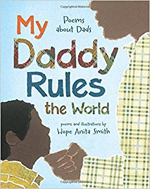 Through fifteen heartwarming poems told from a child's perspective, Hope Anita Smith celebrates and honors the treasured moments between fathers and their children. There are poems about learning to ride a bike, sharing Sunday breakfasts, playing catch, and reading books together. The poems present a diverse array of people and the roles dads play in children's lives. "Some dads go to meetings / and spend hours on the phone. / But my dad has the greatest job—he's a dad that stays at home." Accompanied by Smith's beautiful torn paper collage illustrations, the poems in this collection, which are well-crafted, insightful, and heartfelt, will resonate with young readers. Smith employs accessible language, rhyme schemes, and natural line breaks that make the poems perfect for reading aloud.
Through fifteen heartwarming poems told from a child's perspective, Hope Anita Smith celebrates and honors the treasured moments between fathers and their children. There are poems about learning to ride a bike, sharing Sunday breakfasts, playing catch, and reading books together. The poems present a diverse array of people and the roles dads play in children's lives. "Some dads go to meetings / and spend hours on the phone. / But my dad has the greatest job—he's a dad that stays at home." Accompanied by Smith's beautiful torn paper collage illustrations, the poems in this collection, which are well-crafted, insightful, and heartfelt, will resonate with young readers. Smith employs accessible language, rhyme schemes, and natural line breaks that make the poems perfect for reading aloud.
—MN
Once in a Blue Moon. Danielle Daniel. 2017. Groundwood/House of Anansi.
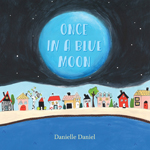 This beautifully illustrated book is comprised of 14 short poems, each starting with “once in a blue moon.” The book opens with the image of a double rainbow and closes with a tree and child in an embrace. Together, the poems serve as an homage to nature as narrators, depicted as children of a variety of races, pay tribute to animals, stars, and other natural phenomena. In one poem, a young girl on a bike spots “a row of ducks” while in another a child sits “deep inside the forest” and watches an eagle overhead. Each four-line poem is paired with a richly colored, folk art-style painting, rendered in acrylics. Poems could be read individually, or the collection shared as a whole, to celebrate connections to the natural world.
This beautifully illustrated book is comprised of 14 short poems, each starting with “once in a blue moon.” The book opens with the image of a double rainbow and closes with a tree and child in an embrace. Together, the poems serve as an homage to nature as narrators, depicted as children of a variety of races, pay tribute to animals, stars, and other natural phenomena. In one poem, a young girl on a bike spots “a row of ducks” while in another a child sits “deep inside the forest” and watches an eagle overhead. Each four-line poem is paired with a richly colored, folk art-style painting, rendered in acrylics. Poems could be read individually, or the collection shared as a whole, to celebrate connections to the natural world.
—LC
Ages 9–11
Miguel’s Brave Knight: Young Cervantes and Don Quixote. Margarita Engle. Ill. Raúl Colón. 2017. Peachtree.
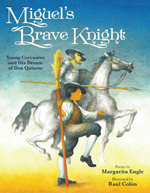 In this collection of narrative poems, Margarita Engle explores the early beginnings of the great Spanish writer Miguel Cervantes and why he is revered as an essential figure in the Western canon. Cervantes's imagination and love of storytelling is detailed throughout this book. As a young boy, Cervantes dreamed of a bumbling knight slaying imaginary monsters. Despite a difficult upbringing, his love for books and stories allowed him to persevere. Engle’s extraordinary wordsmithing captures the spirit and creativity of a young Cervantes in her beautifully crafted lyrical verses: "But when I close my eyes, / the spark of a story flares up. /A tale about a brave knight / who will ride out on / a strong horse / and right /all the wrongs / of this confusing / world." Raúl Colón's pen and ink-and-watercolor illustrations pair perfectly with the text and enhance the subject. The back matter includes author and illustrator notes, and historical and biographical notes. Engaging and exquisitely illustrated, this poetry collection will surely inspire and educate readers.
In this collection of narrative poems, Margarita Engle explores the early beginnings of the great Spanish writer Miguel Cervantes and why he is revered as an essential figure in the Western canon. Cervantes's imagination and love of storytelling is detailed throughout this book. As a young boy, Cervantes dreamed of a bumbling knight slaying imaginary monsters. Despite a difficult upbringing, his love for books and stories allowed him to persevere. Engle’s extraordinary wordsmithing captures the spirit and creativity of a young Cervantes in her beautifully crafted lyrical verses: "But when I close my eyes, / the spark of a story flares up. /A tale about a brave knight / who will ride out on / a strong horse / and right /all the wrongs / of this confusing / world." Raúl Colón's pen and ink-and-watercolor illustrations pair perfectly with the text and enhance the subject. The back matter includes author and illustrator notes, and historical and biographical notes. Engaging and exquisitely illustrated, this poetry collection will surely inspire and educate readers.
—MN
Schomburg: The Man Who Built a Library. Carole Boston Weatherford. Ill. Eric Velasquez. 2017. Candlewick.
 In a series of twenty poems, Weatherford offers readers a biography of the life and work of Arturo Schomburg (1874-1938). Since no other children’s books featuring Schomburg exist, this book will likely function as an introduction for most young readers to this African American historian and book collector. The first poem, “Fifth Grade,” tells of an experience Schomburg had in school during which his teacher tells him that “Africa’s sons and daughters / had no history, no heroes worth noting.” As the story unfolds, readers learn of Schomburg’s move from Puerto Rico to New York City, his jobs and marriages, his obsession with history and founding of the Negro Society for Historical Research, and his devotion to the New York Public Library. Velasquez’s expressive oil paintings capture the time period beautifully. Readers will learn about other neglected figures of African descent as they learn about Schomburg. The book includes ample back matter with a timeline, source notes for quotations, and a bibliography.
In a series of twenty poems, Weatherford offers readers a biography of the life and work of Arturo Schomburg (1874-1938). Since no other children’s books featuring Schomburg exist, this book will likely function as an introduction for most young readers to this African American historian and book collector. The first poem, “Fifth Grade,” tells of an experience Schomburg had in school during which his teacher tells him that “Africa’s sons and daughters / had no history, no heroes worth noting.” As the story unfolds, readers learn of Schomburg’s move from Puerto Rico to New York City, his jobs and marriages, his obsession with history and founding of the Negro Society for Historical Research, and his devotion to the New York Public Library. Velasquez’s expressive oil paintings capture the time period beautifully. Readers will learn about other neglected figures of African descent as they learn about Schomburg. The book includes ample back matter with a timeline, source notes for quotations, and a bibliography.
—LC
Traveling the Blue Road: Poems of the Sea. Lee Bennett Hopkins (Ed.). Ill. Bob Hansmen & Jovan Hansmen. 2017. Seagrass Press.
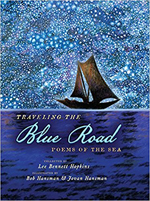 Twelve poets contributed pieces to this collection of 14 poems focused on events at sea. The book is organized chronologically starting in the 15th century and ending in present day. The poems highlight historical periods and some offer detailed context. For instance, Georgia Heard’s poem focused on people fleeing Ireland during the Irish Potato Famine describes “90 days they slept / four to a bunk in a dark hull. / Dazed, dirty, stench in every pore.” The poem goes on to mention a seisún (a traditional Irish music session), adding to the authenticity and historical specificity of the poem. Several of the poems include esoteric words that are translated in a footnote, and some are complemented by quotes about the sea interspersed on the page. The illustrations are rendered in pastels and feature deep blues, thick lines, and a variety textures. The back matter contains photo and quotation credits as well as notes on the poets, typography, and art.
Twelve poets contributed pieces to this collection of 14 poems focused on events at sea. The book is organized chronologically starting in the 15th century and ending in present day. The poems highlight historical periods and some offer detailed context. For instance, Georgia Heard’s poem focused on people fleeing Ireland during the Irish Potato Famine describes “90 days they slept / four to a bunk in a dark hull. / Dazed, dirty, stench in every pore.” The poem goes on to mention a seisún (a traditional Irish music session), adding to the authenticity and historical specificity of the poem. Several of the poems include esoteric words that are translated in a footnote, and some are complemented by quotes about the sea interspersed on the page. The illustrations are rendered in pastels and feature deep blues, thick lines, and a variety textures. The back matter contains photo and quotation credits as well as notes on the poets, typography, and art.
—LC
Ages 12–14
Forest World. Margarita Engle. 2017. Atheneum/Simon & Schuster.
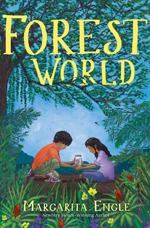 Edver, who lives in Miami with his mom, is obsessed with video games. Luza, who lives in Cuba with her father, loves art and their forest home. When Edver is sent to Cuba to visit his father, he meets his half-sister, Luza. Through alternating poems in each character’s voice, readers get to know these two young people as they discover each other and try to figure out their family history and make a difference in the future of the forest. In the style that earned her the status of Young People’s Poet Laureate, Margarita Engle tells the story of Edver and Luza through the use of metaphors and rich description. As Luza debates how much of herself to reveal to her brother she wonders “if butterflies recognize themselves / while they’re still all wrapped up / inside motionless cocoons.” As Edver learns more about the threats to the environment, he notes, “That’s all it takes to wipe out a species. / Just a few ordinary people making a string / of greedy / decisions.” The varying perspectives of the two narrators will keep readers interested as they learn about Cuba and threats to the environment.
Edver, who lives in Miami with his mom, is obsessed with video games. Luza, who lives in Cuba with her father, loves art and their forest home. When Edver is sent to Cuba to visit his father, he meets his half-sister, Luza. Through alternating poems in each character’s voice, readers get to know these two young people as they discover each other and try to figure out their family history and make a difference in the future of the forest. In the style that earned her the status of Young People’s Poet Laureate, Margarita Engle tells the story of Edver and Luza through the use of metaphors and rich description. As Luza debates how much of herself to reveal to her brother she wonders “if butterflies recognize themselves / while they’re still all wrapped up / inside motionless cocoons.” As Edver learns more about the threats to the environment, he notes, “That’s all it takes to wipe out a species. / Just a few ordinary people making a string / of greedy / decisions.” The varying perspectives of the two narrators will keep readers interested as they learn about Cuba and threats to the environment.
—LC
Macy McMillan and the Rainbow Goddess. Shari Green. 2017. Pajama Press.
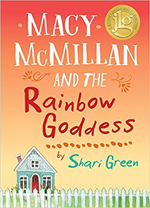 In this poignant verse novel, readers will be touched by the humor and heroism of Macy McMillian, who faces unwanted changes in her life as her mother is remarrying and she soon will be forced to move into a different home with her new stepdad and two stepsisters. The move also means a new school and a new sign language interpreter for her. To make matters worse, a fight with her best friend leaves her feeling even more isolated. Things start to change when her mother asks her to help their elderly neighbor Iris, also known as "the Rainbow Goddess." Iris doesn't know any sign language but it doesn't take long for the pair to find ways to communicate about their shared love of books. Iris also shares life lessons through cookie metaphors, such as: "Oatmeal cookies say / you're strong enough . . . you can do this” and “Peanut butter cookies send joy / and laughter.” While Macy’s deafness is a feature of the book, the focus is her gradual acceptance of the changes in her life. This novel in verse is an accessible read about the families we chose for ourselves and the power of stories.
In this poignant verse novel, readers will be touched by the humor and heroism of Macy McMillian, who faces unwanted changes in her life as her mother is remarrying and she soon will be forced to move into a different home with her new stepdad and two stepsisters. The move also means a new school and a new sign language interpreter for her. To make matters worse, a fight with her best friend leaves her feeling even more isolated. Things start to change when her mother asks her to help their elderly neighbor Iris, also known as "the Rainbow Goddess." Iris doesn't know any sign language but it doesn't take long for the pair to find ways to communicate about their shared love of books. Iris also shares life lessons through cookie metaphors, such as: "Oatmeal cookies say / you're strong enough . . . you can do this” and “Peanut butter cookies send joy / and laughter.” While Macy’s deafness is a feature of the book, the focus is her gradual acceptance of the changes in her life. This novel in verse is an accessible read about the families we chose for ourselves and the power of stories.
—MN
Ages 15+
This Impossible Light. Lily Myers. 2017. Philomel/Penguin.
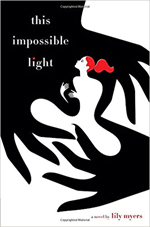 As she enters her second year of high school, Ivy finds her life falling apart. Her parents have divorced, her brother has moved out, and her best friend, who was away for the summer, may not be her best friend anymore. The series of short poems in Ivy’s voice take on a wide range of issues from depression to eating disorders. Ivy excels in school, especially in math, and one teacher invites her to participate in a scholarship competition. Will her eating disorder stop her from making it into the competition? The book is divided into sections based on mathematical concepts, and Ivy describes her binging and purging in those terms: “And I know / that the lower my x is / the less I put inside of me / the better / my output / will be.” Ivy’s language is honest and raw as she navigates her pain and confusion. While the book’s ending is a bit too tidy, Ivy’s perspective will resonate with young readers, especially those who may be struggling with similar problems.
As she enters her second year of high school, Ivy finds her life falling apart. Her parents have divorced, her brother has moved out, and her best friend, who was away for the summer, may not be her best friend anymore. The series of short poems in Ivy’s voice take on a wide range of issues from depression to eating disorders. Ivy excels in school, especially in math, and one teacher invites her to participate in a scholarship competition. Will her eating disorder stop her from making it into the competition? The book is divided into sections based on mathematical concepts, and Ivy describes her binging and purging in those terms: “And I know / that the lower my x is / the less I put inside of me / the better / my output / will be.” Ivy’s language is honest and raw as she navigates her pain and confusion. While the book’s ending is a bit too tidy, Ivy’s perspective will resonate with young readers, especially those who may be struggling with similar problems.
—LC
Lesley Colabucci is an associate professor of early, middle, and exceptional education at Millersville University. She teaches classes in children’s literature at the graduate and undergraduate level. Her research interests include multicultural children’s literature and response to literature. Mary Napoli is an associate professor of Reading and Children’s Literature at Penn State Harrisburg, where she teaches both undergraduate and graduate literacy courses.